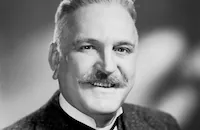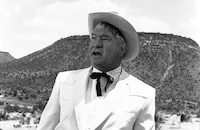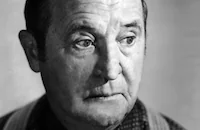Boom Town

Brief Synopsis
Cast & Crew
Jack Conway
Clark Gable
Spencer Tracy
Claudette Colbert
Hedy Lamarr
Frank Morgan
Film Details
Technical Specs

Synopsis
On the day that his wildcat well comes in, Betsy Bartlett arrives to see her boyfriend, Square John Sand, and meets Big John McMasters, Square John's partner in the oil venture. It is love at first sight for Betsy and Big John, and they marry, much to Square John's disappointment. After a year of domesticity, the lure of the wildcatting life infects Big John, and Square John, angry at his partner's treatment of Betsy, tosses a coin for ownership of the well. Square John wins and Big John and Betsy take to the road, where after hitting it rich in the Oklahoma oil fields, Big John becomes a major power in the industry. In his role as oil baron, Big John meets wheeler dealer Harry Compton and his companion, Karen Vanmeer, and decides to expand his investments to the oil refineries back East. In New York, Big John begins to spend his time with Karen and neglect his wife and young son Jack. To help Betsy win back Big John, Square John teams with Compton in a business fight, which brings Big John to the attention of the government, which charges him with violation of the Sherman Anti-Trust Act. At the trial, Square John comes to his ex-partner's rescue and testifies that Big John was really trying to conserve the supply of oil rather than trying to break the law. Big John is then vindicated and rejoins his wife and old partner to wildcat once more.

Director

Jack Conway
Cast

Clark Gable

Spencer Tracy

Claudette Colbert

Hedy Lamarr

Frank Morgan

Lionel Atwill

Chill Wills

Marion Martin

Minna Gombell

Joe Yule
Horace Murphy

Roy Gordon

Richard Lane
Casey Johnson
Baby Quintanilla
George Lessey

Sara Haden

Curt Bois

Frank Orth
Frank Mcglynn Sr.
Dick Curtis
Parker Barnett

Nestor Paiva
Crew
Adrian
Ford Alexander
Samuel Cohen
Cedric Gibbons
Arnold Gillespie
Henry Grace
Sydney Guilaroff
John Hoffman
Horace Hough
Hugh Hunt
Eddie Imazu
John Lee Mahin
Jack D. Moore
Ray Ramsey
Harold Rosson
Blanche Sewell
Douglas Shearer
Gile Steele
Franz Waxman
Edwin B. Willis
Sam Zimbalist

Photo Collections
Videos
Movie Clip




Trailer
Hosted Intro
Film Details
Technical Specs

Award Nominations
Best Cinematography
Best Special Effects
Articles
Boom Town
Boom Town recreates in the purest sense an early twentieth century vision of the American Dream. The idea that two rough and tumble Texas men can recycle poverty and wealth again and again reinforced the prevailing spirit of that dream; one of the film's promotional tag lines was "Men born of the lasting miracle that is America." Whether true or not, the concept that anyone with enough gumption, desire and hard work could break through any form of class structure and eventually reach the top of society, had a strong appeal for a public that was just starting to come out of the Great Depression. When you add the additional subplot of Spencer Tracy's unrequited love for Claudette Colbert who's stolen away by Gable, you have the formula for a giant, box office smash. Thrown into the mix is the alluring Hedy Lamarr as a potential threat to Gable's marriage and an excellent supporting cast including Frank Morgan, Chill Wills and Lionel Atwill. All this, combined with fast paced action sequences, crisp dialogue and the unadulterated themes of life long friendships and lasting romantic love, make Boom Town an enormously entertaining example of MGM's prestige productions of the forties.
In real life Gable and Tracy enjoyed working with one another. With the movies San Francisco (1936) and Test Pilot (1938) they already had two successful projects under their belts. And even though Boom Town was just as profitable as their previous hits, it would be their last film together - and arguably their best. The duo generates a believable dramatic tension when together on-screen and their fight scenes are particularly effective. When filming one of the latter sequences, Gable insisted on doing his own stunt work. Tracy, however, used a double who accidentally landed a blow to Gable's face, cutting the actor's lip and breaking his dentures which required a break in shooting for a week. After the movie was completed Tracy decided he was tired of playing the best friend who watched while his pal Gable won the girl. He wanted to be a star in his own right.
Tracy had already been brooding about this during the making of Boom Town and was irritable and withdrawn throughout the production. The native Parisian, Claudette Colbert, didn't like the fact that Tracy called her either "Frenchie" or "Froggie" and distanced himself from everyone on the set. Moreover, his relationship with Hedy Lamarr, a combative one in the film, was also an outright hostile pairing in real life. For example, in one scene the self-sacrificing Tracy is trying to drive Lamarr off to protect Gable and Colbert's marriage for Colbert's sake and he aggressively pokes Lamarr in the chest repeatedly. If you look closely, you'll see that she pushes his hand away at the end of the scene with a great deal of disdain, each of them giving each other a stone-cold stare at the scene's fade-out.
For the press and the public, there was a great deal of excitement over the Gable/Colbert reunion, their first in six years after their legendary performances in the seminal romantic comedy It Happened One Night (1934). That film was the first to win all five major Oscars, including Best Actor and Best Actress for Gable and Colbert. At the same time there was an equal amount of anticipation surrounding Hedy Lamarr's appearance in Boom Town. Though probably the least known of the four MGM stars today, she was being groomed for superstardom by her studio in the late thirties/early forties. Having jet-black hair and brilliant green eyes in an age of platinum blondes, she stood out as one of the most beautiful women of her era. Even before she portrayed the memorable fourth wheel in Boom Town, she had already gained a certain degree of international fame. In fact, her life was the stuff from which myths are made.
Born Hedwig Eva Maria Kiesler, in Vienna, the daughter of a banker, she gained worldwide notoriety when she appeared nude in the Czech film, Ecstasy (1932). Shortly afterwards she would marry Fritz Mandel, an Austrian munitions magnate, who would introduce her to such world figures as Mahler, Hitler and Mussolini. He would also treat her as just another beautiful possession of his, causing Lamarr to disguise herself as one of her servants, eventually escaping to Paris. Guided by Louis B. Mayer, she emigrated to the United States with every intention of becoming a star. Primarily because the prudish Mayer was embarrassed by Lamarr's nude appearance in Ecstasy, he changed her name from Kiesler to Lamarr to avoid any connection with what he considered her risque former life. After her eye-catching performance in the film, Algiers (1938), Mayer declared that she would become the studio's "most important star." To illustrate how popular Hedy Lamarr was during the war years, a kiss from her at fund raising efforts cost the price of a $25,000 bond. However, in a relatively short space of time, she suffered several box office failures, including what most film aficionados feel is one of the worst movies MGM ever made, I Take This Woman (1939). Part of the problem was that Mayer forced Lamarr to accept roles she didn't want like Lady of the Tropics (1939) plus she wasn't always the best judge of scripts herself. For example, she turned down Laura (1944), as well as two of Ingrid Bergman's biggest hits, Gaslight (1944) and Saratoga Trunk (1945), among other well known classics. In her own defense, Lamarr recounted in her autobiography, Ecstasy and Me, how she lobbied hard for the secondary role in Boom Town which she saw as "not big, but gutsy. A perfect vehicle for me to prove my ability." Mayer finally relented and let her take the second female lead. Lamarr wrote, "I was deadly serious all during the making of it. I needed this one and it had to be good. Clark was kind to me all during the film. Spencer was aloof but worked hard. When a picture is going good everyone feels it. We felt all during the filming we had a good one. And it was. The reviews were a smash." Unfortunately, Lamarr's screen successes were few and by the late '50s her career was over.
Interestingly, a piece of information would surface late in Hedy Lamarr's life that would go against the image of her as just another pretty face on the screen. In 1997 authorities revealed that in 1940 after her emigration to the United States and subsequent stardom, Lamarr used her knowledge of weaponry learned under the auspices of her former husband, Mandel, in a way that would serve as the foundation for today's secure military communications. Together with the help of composer George Antheil, she created an anti-jamming device for the Allies in World War Two. Using paper rolls with perforations that exactly matched the split-second hops of radio frequencies, the device was an important contribution to the Allied war effort. That's something to think about when we watch Lamarr as that slinky woman in gorgeous black and white in Boom Town. With this film, she proved she could create a fully rounded character who depended on other qualities besides her stunning beauty. It's a character much like herself: sexy, smart and a more substantial person than appearances would have you believe.
Producer: Sam Zimbalist
Director: Jack Conway
Screenplay: John Lee Mahin
Cinematography: Woody Bredell, Harold Rosson
Costume Design: Adrian, Gile Steele
Film Editing: Paul Landres, Blanche Sewell
Original Music: Daniele Amfitheatrof, Franz Waxman
Cast: Clark Gable (Big John McMasters), Spencer Tracy (Square John Sand), Claudette Colbert (Betsy Bartlett), Hedy Lamarr (Karen Vanmeer).
BW-119m. Closed captioning.
by Joseph D'Onofrio

Boom Town
Quotes
Trivia
Notes
Although onscreen credit list Harold Rosson as photographer, Film Daily credits Elwood Bredell with photography. Onscreen credits also list Blanche Sewell as editor, but modern sources credit Paul Landers. According to news items in Hollywood Reporter, the leading female role in this picture was originally written for Myrna Loy. Another item in Hollywood Reporter notes that technical advisor Ford Alexander was a real-life oil fire fighter. The film was shot partially on location in Bakersfield, CA. A pre-release news item in Hollywood Reporter adds that M-G-M decided to run this picture on a single bill and increase the admission price. The studio's justification for this policy was that with so many stars, it was actually "four films in one." In the movie Hulabaloo, star Frank Morgan impersonated the voices of Clark Gable, Spencer Tracy and Claudette Colbert in a re-enactment of a scene from Boom Town. Boom Town was nominated for the following Academy Awards: Best Black and White Cinematography, Best Special Photographic Effects and Best Sound Recording. This was the last of three films starring Clark Gable and Spencer Tracy. They also starred together in the 1936 film San Francisco (see below) and the 1938 film Test Pilot (see below). This was the second and last pairing of Gable and Claudette Colbert following their appearance in the Oscar winning film It Happened One Night (see below).

Miscellaneous Notes
Released in United States 1940
Released in United States 1940















